Overland to Lhasa: Top Five Overland Routes to Tibet
Traveling overland to Lhasa is an adventurous journey through the spectacular scenery of the Tibetan Plateau. There are five different routes that can take you over the Himalayas or across the varied landscapes of eastern, northern, or western Tibet. No matter which route you choose, you can enjoy a unique journey leading to the iconic wonders of Lhasa. Read on to learn details about these top five overland routes to Tibet and find the best trip for your next adventure.
Overland to Lhasa from Kathmandu: The Most Popular Route across the Himalayas
If you are looking to explore the Himalayas views, then the overland trip from Kathmandu to Lhasa is your best option. Taking about 8 days, this thrilling journey lets you pass through incredible landscapes that transform from dense forests, to jagged mountain peak, and then the vast expanse of the Tibetan Plateau. See incredible natural wonders and visit remote temples and villages before arriving in Lhasa to tour iconic sites like Potala Palace and Jokhang Temple.
Amazingly, most of the route is along a well-maintained, modern highway. It starts from Kathmandu, passing through Langtang National Park on the way to the border crossing at Gyirong. The Gyirong Valley has been called the most beautiful valley in the world and is a scenic place of dense forests and Sherpa villages.
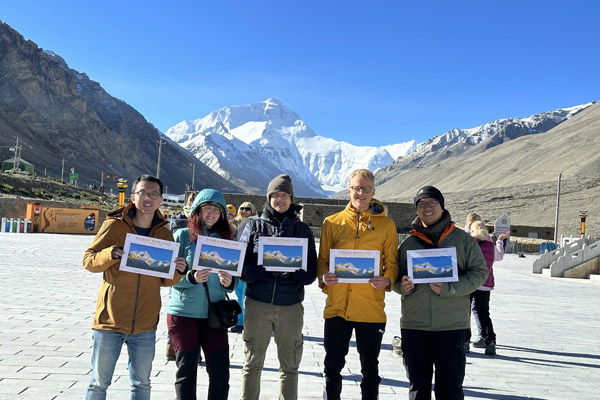 The overland route from Kathmandu to Lhasa will take you to Everest Base Camp en route.
The overland route from Kathmandu to Lhasa will take you to Everest Base Camp en route.On the third day, you begin the ascent to Everest Base Camp, crossing Kong Tang Lamu Pass (5,236m) and seeing Mount Shishabangma (8,027m) with Pelku Lake at its foot. Admire the breathtaking sight of the world’s highest peak at Everest Base Camp, and visit Rongbuk Monastery, the highest monastery in the world, before continuing to Tingri for an overnight stay.
The next leg of the journey takes you to Tibet’s second largest city, Shigatse. Shigatse is home to Tashilhunpo Monastery. The seat of the Panchen Lama is one of the most important monasteries in Tibet and home to the world’s largest statue of Maitreya Buddha. On the final stretch to Lhasa you’ll see Karola Glacier and the holy Yamdrok Lake (4,400m).
End the tour with a tour in Lhasa. The endless list of must-see places in Tibet’s capital includes Potala Palace, the symbol of Tibet, and Jokhang Temple, the heart of Tibetan Buddhism.
Overland to Lhasa from Chengdu: The Most Scenic Route via the G318 Highway
The overland trip from Chengdu to Lhasa travels over 2,000 km along the G318 Highway to travel through Tibet from the east. Chengdu is a historic city home to the world-famous Sichuan cuisine, and the sight of the Giant Panda Research Base. It’s a beautifully scenic route through rolling hills and valleys, and the lakes and forests of eastern Tibet.
The 7-day Chengdu to Lhasa Overland Tour sets out through the Chengdu Plains to see the landscapes of Sichuan with scenes like snow-capped Mount Siguniang, and the serene villages around Xinduqiao. The highland grasslands of the Maoya Prairie are home to wildlife like cattle, sheep, antelopes, and yellow ducks.
Enter Tibet through the stunning canyon area of Zogong, home to mountains like Mount Lawu and Mount Dongda. One of the most exciting stretches of the route is the area known as the "Nujiang River 72 Turns." The winding stretch of 180° turns descends from the mountains to the riverside.
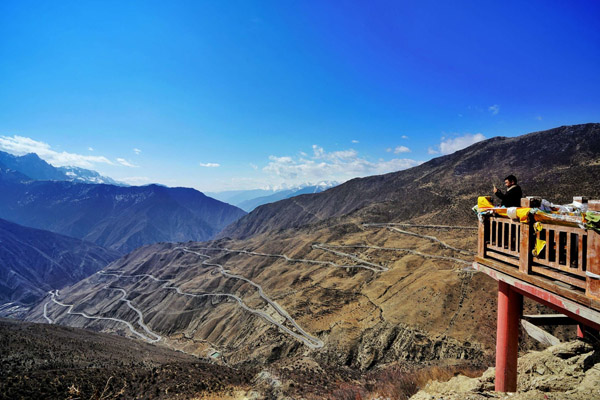 Nujiang River 72 Turns is a stunning site on the Chengdu to Lhasa G318 Highway.
Nujiang River 72 Turns is a stunning site on the Chengdu to Lhasa G318 Highway.Eastern Tibet is an often overlooked area home to the enchanting Lulang Forest. Mount Namcha Barwa (7,782m) marks the eastern end of the Himalayas, and you can see the most beautiful glacier in China, the Midui Glacier. The last stretch is from Nyingchi to Lhasa, with stops at Tsozong Gompa Temple and amazing Basum Tso Lake.
Overall, the road along this route is well-paved, but some sections might be affected by weather like rainfall. So it is better to travel the route during spring and autumn, when the weather is stable and mild.
Overland to Lhasa from Kunming: Following the Ancient Tea Horse Route
Kunming, the ‘city of eternal spring’ and capital of Yunnan Province is the start of a journey to Lhasa along the Ancient Tea Horse Route. The 1,930 km trip takes 12 days through beautiful scenery of gorges, glaciers, rivers, and mountains, and gives you the chance to see the culture of the Dongba and Naxi peoples.
The first stop is the ancient town of Lijiang, in the northwest of Yunnan, bordering Sichuan. The Old Town is a UNESCO World Heritage Site lying near the famous Jade Dragon Snow Mountain. Then, it’s on to the legendary Shangri-la where you can see Songzanlin Temple and Bitahai Lake.
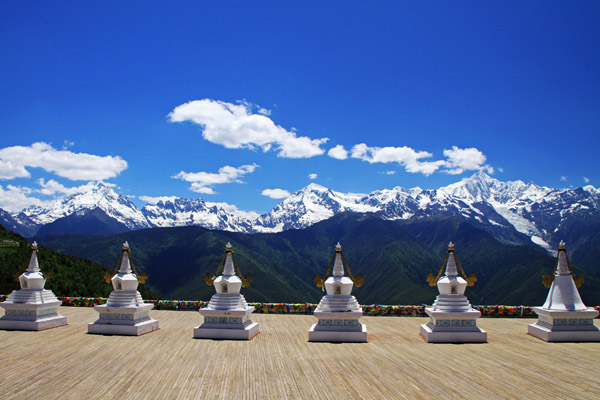 You can see Meri Snow Mountains by traveling overland from Kunming to Lhasa.
You can see Meri Snow Mountains by traveling overland from Kunming to Lhasa.Towering mountains and glaciers mark the approach to Tibet on the way to Deqen. Located in Diqing Tibetan Autonomous Prefecture, you can see the Meri Snow Mountains, and Lantsang Gorge. On the road from Yanjing to Markam you can stop to relax at the Quzika Hot Spring before entering Tibet through Zogang in Chamdo Prefecture.
Chamdo Prefecture, from Zogang to Ranwu, is full of beautiful landscapes including the Lancang and Nujiang Rivers, and Bangda Prairie. The grasslands produce important medicinal plants such as cordyceps, fritillaria, and rhodiola rosea. Nyginchi Prefecture is the next section with sites like Qujiaowu Temple and Mount Namcha Barwa. From Nyingchi to Lhasa, you can see the sacred Basum Lake, and cross over the Mila mountain pass at over 5,000m.
Overland to Lhasa from Xining: The Shortest Route Overlapping the Qinghai-Tibet Railway
The Xining to Lhasa overland route is the shortest way to travel by car to Tibet. It travels along the Qinghai-Tibet Highway that parallels the famous Qinghai-Tibet Railway. The highway stretches for 1,947 km, and is an engineering marvel with an average elevation of 4,000m.
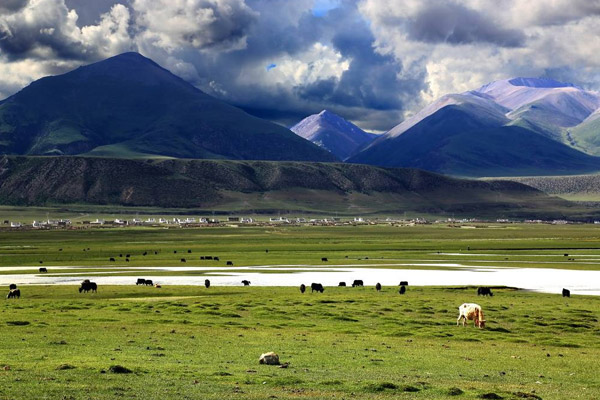 The Qiangtang Grassland along the way of Xining to Lhasa overland route
The Qiangtang Grassland along the way of Xining to Lhasa overland routeThe Xining to Lhasa Overland Tour takes 11 days. It sets out from Xining visiting the Kumbum Monastery on the way to Qinghai Lake. On the way to Golmud, via Chaka, there are natural wonders like Chaka Salt Lake with its magical looking natural crystals and mirror-like surface.
From Golmud to Tuotuoheyan you’ll cross over the Kunlun Pass (4,837m), the first high mountain pass of the journey. Then, cross the Tanggula Mountains on the way to Naqu and be treated to the site of grazing animals dotting the grasslands. The Qiangtang Grassland is home to nomadic people who you can visit and try fresh yak milk.
Namtso Lake, one of the three holy lakes in Tibet, awaits with its stark beauty. Stay for the stunning sunset, and enjoy the glow of the Milky Way as the stars come out. The last stop before Lhasa is Chimelong Monastery and Tsurphu Monastery. You can explore these less-traveled temples before arriving in Lhasa.
Overland to Lhasa from Kashgar: The Most Challenging Route across Western Tibet
Kashgar, the ancient hub of the Silk Road in far the west Xinjiang Autonomous Region, is the start of the most challenging route to Lhasa through remote western Tibet. The 16/17 journey spans over 2,900 km through some of the world’s isolated areas. It travels through breathtaking landscapes, past the ruins of ancient kingdoms, and includes a trek to one of the holiest mountains in the world.
Kashgar is an oasis, and departing the city will plunge you into the Taklamakan Desert on the way to Yecheng. Long stretches of road pass between the Kunlun and Karakorum Mountain Ranges and take you to Pangong Tso Lake.
The next major site is the ruins of the Guge Kingdom in Zanda County. Explore the remains of fortresses and palaces with their carving and Buddha statues. Then arrive in Darchen for the start of the trek around Mount Kailash. Mount Kailash is sacred to followers of four religions, and attracts trekkers and pilgrims for the 3-day route around the mountain.
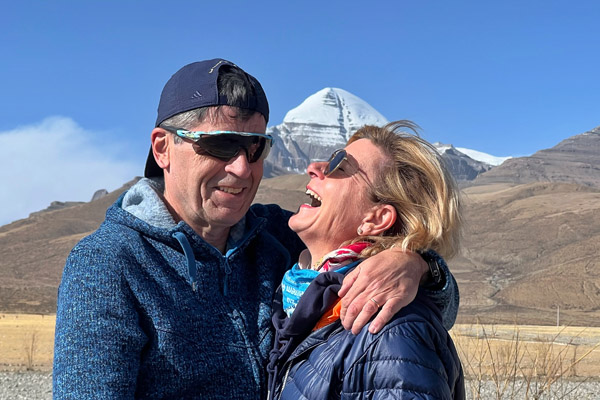 One highlight along Xinjiang Tibet Highway is the holy Mount Kailash.
One highlight along Xinjiang Tibet Highway is the holy Mount Kailash.After the trek, the route travels to Saga through the beautiful Ngari Plateau with views of the Himalayas, and the Gangdise Mountains. From Saga, travel to Old Tingri via Tong La Pass (5,100 m). This is the last stop before Everest Base Camp and the best view you can have of the peak of Mount Everest.
Visit the highest monastery in the world, Rongbuk Monastery before setting out for Shigatse. On the way from Tibet’s second largest city to Lhasa you can visit he Perklor Monastery and Kumbum Stupa in Gyantse, and stop at Yamdrok Lake, one of the holiest in Tibet.
Insider Tips for Traveling Overland to Lhasa, Tibet
(1) Generally May to October is the best time to travel overland to Lhasa. The weather will be relatively mild, and road conditions are safe for driving. But it is important to check weather before your departure, especially in summer season when rainfall may affect the roads.
(2) Pack layers of clothes to be able to adapt to changing temperatures. Sunscreen, sunglasses, and lip balm are also essential to protect against the harsh sun and dry air.
(3) The high elevations pose a risk for altitude sickness. Take the opportunity to acclimatize in lower altitude regions like Xining or Gyirong before ascending to higher areas.
(4) Choose a reputable tour operator to ensure you have an experienced driver and well-maintained vehicle. A good tour operator like us will also ensure you have the required permits like Tibet Travel Permit.
Conclusion
Whether you choose the popular Kathmandu route, the scenic G318 Highway from Chengdu, the historic Tea Horse Road from Kunming, the accessible route from Xining, or the challenging expedition from Kashgar, each path promises unforgettable experiences. With proper planning and an adventurous spirit, traveling overland to Lhasa can be one of the most rewarding journeys you’ll ever undertake. If you still have any question about Tibet overland travel, please feel free to contact us or book your tour with us today.
 BACK
BACK
0 Comment ON "Overland to Lhasa: Top Five Overland Routes to Tibet"